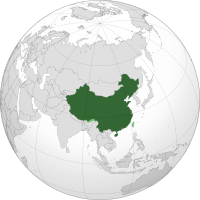 Map of the People's Republic of China in dark green with the disputed territories in light green Map of the People's Republic of China in dark green with the disputed territories in light green | |
| Location | |
|---|---|
| Country | People's Republic of China |
| Continent | Asia |
| Regulator | Ministry of Industry and Information Technology |
| Type | Open |
| Access codes | |
| Country code | +86 |
| International access | 00 |
| Long-distance | 0 |

Telephone numbers in the People's Republic of China are administered according to the Telecommunications Network Numbering Plan of China. The structure of telephone numbers for landlines and mobile service is different. Landline telephone numbers have area codes, whereas mobile numbers do not. In major cities, landline numbers consist of a two-digit area code followed by an eight-digit local number. In other places, landline numbers consist of a three-digit area code followed by a seven- or eight-digit local number. Mobile phone numbers consist of eleven digits.
Landline calls within the same area do not require the area code. Calls to other areas require dialing the trunk prefix 0 and the area code.
The special administrative regions of Hong Kong and Macau are not part of this numbering plan, and use the calling codes 852 and 853 respectively.
Mobile phones
In mainland China, mobile phone numbers have eleven digits in the format 1xx-XXXX-XXXX (except for 140–144, which are 13-digit IoT numbers), in which the first three digits (13x to 19x) designate the mobile phone service provider.
Before GSM, mobile phones had 6-digit (later upgraded to 7-digit) numbers starting with nine. They had the same numbering format as fixed-line telephones. Those numbers were eventually translated into 1390xx9xxx, where xx were local identifiers.
The oldest China Mobile GSM numbers were ten digits long and started with 139 in 1994, the second oldest 138 in 1997, and 137, 136, 135 in 1999. The oldest China Unicom numbers started with 130 in 1995, the second oldest at 131 in 1998. Keeping the same number over time is somewhat associated with the stability and reliability of the owner. The 5th to the seventh digit sometimes relates to age and location.
China's mobile telephone numbers were changed from ten digits to eleven digits, with 0 added after 13x, and thus the HLR code became four-digit long to expand the capacity of the seriously fully crowded numbering plan.
In 2006, 15x numbers were introduced. In late 2008, 18x and 14x (for data plans or IoT) were introduced. In late 2013, 17x were introduced. In 2017, 16x and 19x were introduced.
In December 2016, each cell phone number was required to be consigned to a real name in mainland China.
In November 2010, MIIT has started the trial mobile number portability service in Tianjin and Hainan, in 2012 the trial has extended to Jiangxi, Hubei and Yunan provinces. On 10 November 2019, all provinces started accepting MNP requests for all mobile carriers, except for technical difficulties, the MVNO phones, satellite phones and IoT phones.
Mobile service carriers can be identified by the first three or four digits as follows:
| Prefix | Carrier | Network | |||
|---|---|---|---|---|---|
| 2G | 3G | 4G | 5G | ||
| 10641 (13 digits) | China Unicom (VNO for IoT purposes) | N/A | WCDMA | LTE | NR |
| 130–132 | China Unicom | N/A | WCDMA | LTE | NR |
| 133 | China Telecom | N/A | LTE | NR | |
| 134(0–8) | China Mobile | GSM | N/A | LTE | NR |
| 1349 | Chinasat (operated by China Telecom) | Satellite | |||
| 135–139 | China Mobile | GSM | N/A | LTE | NR |
| 140 (13 digits) | reserved for China Unicom (IoT), due to NR technical difficulties, no 1400(0-9) numbers will be provided | N/A | |||
| 141 (13 digits) | China Telecom (IoT) currently only 1410(0-9) are used, the rest, 141(10-99) are reserved for future 5G IoT card plans |
N/A | LTE | NR | |
| 142–143 (13 digits) | reserved for future IoT carriers | N/A | |||
| 144 (13 digits) | China Mobile (IoT) currently only 1440(0-9) and 1441(0-9) are used, the rest, 144(20-99) are reserved for future 5G IoT card plans |
GSM | N/A | LTE | NR |
| 145 | China Unicom (formerly Data-plans only) only new TD-LTE, LTE-FDD, LTE-A or NR wireless network card users may got a new 145 number, but can also be used to connect 3G network |
N/A | WCDMA | LTE | NR |
| 146 | China Unicom (IoT) | N/A | WCDMA | LTE | NR |
| 147 | China Mobile (formerly Data-plans only) Used for "one SIM with dual-number" service of CMHK in Mainland |
GSM | N/A | LTE | NR |
| 148 | China Mobile (IoT) | GSM | N/A | LTE | NR |
| 149 | China Telecom (formerly Data-plans only) only new TD-LTE, LTE-FDD, LTE-A or NR wireless network card users may got a new 149 number |
N/A | LTE | NR | |
| 150–152 | China Mobile | GSM | N/A | LTE | NR |
| 153 | China Telecom | N/A | LTE | NR | |
| 154 | reserved for future mobile carriers | N/A | |||
| 155–156 | China Unicom | N/A | WCDMA | LTE | NR |
| 157 | China Mobile also used for CM wireless landlines |
GSM | N/A | LTE | NR |
| 158–159 | China Mobile | GSM | N/A | LTE | NR |
| 161 | reserved for future mobile carriers | N/A | |||
| 162 | China Telecom (VNO) | N/A | LTE | NR | |
| 164 | reserved for future mobile carriers | N/A | |||
| 165 | China Mobile (VNO) | GSM | N/A | LTE | NR |
| 166 | China Unicom | N/A | WCDMA | LTE | NR |
| 167 | China Unicom (VNO) | N/A | WCDMA | LTE | NR |
| 170(0-2) | China Telecom (VNO) | N/A | LTE | NR | |
| 1703 | China Mobile (VNO) | GSM | N/A | LTE | NR |
| 1704 | China Unicom (VNO) | N/A | WCDMA | LTE | NR |
| 170(5-6) | China Mobile (VNO) | GSM | N/A | LTE | NR |
| 170(7-9) | China Unicom (VNO) | N/A | WCDMA | LTE | NR |
| 171 | China Unicom (VNO) also used by Hong Kong 3 as sub-number of their SIM cards in Mainland |
N/A | WCDMA | LTE | NR |
| 172 | China Mobile (IoT)
Used for "one SIM with dual-number" service of CTM in Mainland |
GSM | N/A | LTE | NR |
| 173 | China Telecom | N/A | LTE | NR | |
| 174(00-05) | Tiantong (operated by China Telecom) | Satellite | |||
| 174(06-12) | MIIT Emergency Communication Support Center | emergency mobile call | |||
| 174(13-89) | reserved for satellite phones | N/A | |||
| 1749 | Inmarsat | Satellite | |||
| 175–176 | China Unicom | N/A | WCDMA | LTE | NR |
| 177 | China Telecom | N/A | LTE | NR | |
| 178 | China Mobile | GSM | N/A | LTE | NR |
| 180–181 | China Telecom | N/A | LTE | NR | |
| 182–184 | China Mobile | GSM | N/A | LTE | NR |
| 185–186 | China Unicom | N/A | WCDMA | LTE | NR |
| 187–188 | China Mobile | GSM | N/A | LTE | NR |
| 189–191 | China Telecom | N/A | LTE | NR | |
| 192 | China Broadnet | N/A | LTE | NR | |
| 193 | China Telecom | N/A | LTE | NR | |
| 194 | reserved for future mobile carriers | N/A | |||
| 195 | China Mobile | GSM | N/A | LTE | NR |
| 196 | China Unicom | N/A | WCDMA | LTE | NR |
| 197–198 | China Mobile | GSM | N/A | LTE | NR |
| 199 | China Telecom | N/A | LTE | NR | |
- China Unicom before 2009
- Operated by China Transport Telecommunication Information Group Co., Ltd.
- TD-SCDMA networks deprecated by China Mobile in 2020
- China Unicom finalize deprecated the GSM networks in 2021. A plan to deprecate GSM by China Mobile announced in 2023, scheduled to shut down in 2025
- CDMA2000 1x Ev-Do networks deprecated in 2022, and CDMA2000 1x RTT in 2024
- LTE compatibility of China Broadnet SIM cards only available on Apple iOS devices
- WCDMA networks are being deprecated by China Unicom since 2023
1G TACS networks were provided by China Telecom since 1987, operations transferred to China Mobile in 1999, the year China Mobile established, 1G shut down in 2001.
Calling formats
To call phone numbers in China one of the following formats is used:
- For fixed phones:
xxx xxxx | xxxx xxxx Calls within the same area code
0yyy xxx xxxx | 0yyy xxxx xxxx Calls from other areas within China
+86 yyy xxx xxxx | +86 yyy xxxx xxxx Calls from outside China
- For mobile phones:
1nn xxxx xxxx Calls to mobile phones within China
+86 1nn xxxx xxxx Calls to mobiles from outside China
Area 1 – Capital Operation Center
The prefix one is used exclusively by the national capital, Beijing Municipality.
- Beijing – 10 (formerly 1, abolished after GSM was introduced, to avoid conflict with mobile phone numbers with prefix 0 added (e.g. 0139-xxxx-xxxx))
Area 2 – Country Communication System Operating Center
These are area codes for the municipalities of Shanghai, Tianjin, and Chongqing, as well as several major cities with early access to telephones. These cities have upgraded to an 8-number system in the past decade. All telephone numbers are 8-digit in these areas.
- Shanghai – 21
- Tianjin – 22
- Chongqing – 23
- Shenyang, Tieling, Fushun, Benxi – 24
- Nanjing – 25
- Wuhan, Huarong District of Ezhou – 27
- Chengdu, Meishan, Ziyang – 28
- Xi'an, Xianyang – 29
- Guangzhou – 20
1 - Formerly 811 in urban area and 814 in Yongchuan, both abolished on 9 August 1997; 819 for Wanxian and 810 for Fuling and Qianjiang, abolished on 28 November 1998.
2 - Formerly 410 for Tieling and 413 for Fushun, abolished on 28 August 2011; 414 for Benxi, abolished on 24 May 2014.
3 - Formerly 832, 833, abolished 2010.
4 - Formerly 910, abolished 2006.
It's still unclear whether 26 will be provided or not, some local materials say that it's reserved for Taiwan (especially its capital Taipei), but currently they use +886. Some proposals from planned independent cities (Chinese: 计划单列市) to get rights to operate 026 were also unsuccessful.
Area 3 – Northern China Operation Center
These are area codes for the provinces of Hebei, Shanxi and Henan.
Hebei – 31x 33x
 Shijiazhuang
Shijiazhuang311
(8-digit) Tangshan
315 Qinhuangdao
335 Handan
310 Xingtai
319 Baoding
312 Zhangjiakou
313 Chengde
314 Cangzhou
317 Langfang
316 Hengshui
318
Shanxi – 34x 35x
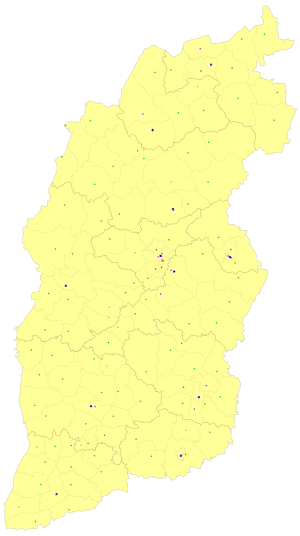 Taiyuan
Taiyuan351 Datong
352 Yangquan
353 Changzhi
355 Jincheng
356 Shuozhou
349 Jinzhong
354 Yuncheng
359 Xinzhou
350 Linfen
357 Lüliang
358
Henan – 37x 39x
 Zhengzhou
Zhengzhou371
(8-digit) Kaifeng
371
(8-digit) Luoyang
379
(8-digit) Pingdingshan
375 Anyang
372 Hebi
392 Xinxiang
373 Jiaozuo
391 Puyang
393 Xuchang
374 Luohe
395 Sanmenxia
398 Nanyang
377
(8-digit) Shangqiu
370 Xinyang
376 Zhoukou
394 Zhumadian
396 Jiyuan
391
1 - Formerly 378, abolished on 26 October 2013.
2 - Formerly 397 for 7 east counties, abolished on 20 October 2005.
Area 4 – Northeastern China Operation Center
These are area codes for the autonomous region of Inner Mongolia, and the provinces in Northeast China (Liaoning, Jilin, and Heilongjiang). Additionally, numbers starting 400 are shared-pay (callers are charged local rate anywhere in the country) numbers .
Liaoning – 41x 42x
 Shenyang
Shenyang24
(8-digit) Dalian
411
(8-digit) Anshan
412 Fushun
24
(8-digit) Benxi
24
(8-digit) Dandong
415 Jinzhou
416 Yingkou
417 Fuxin
418 Liaoyang
419 Panjin
427 Tieling
24
(8-digit) Chaoyang
421 Huludao
429
Jilin – 43x 44x
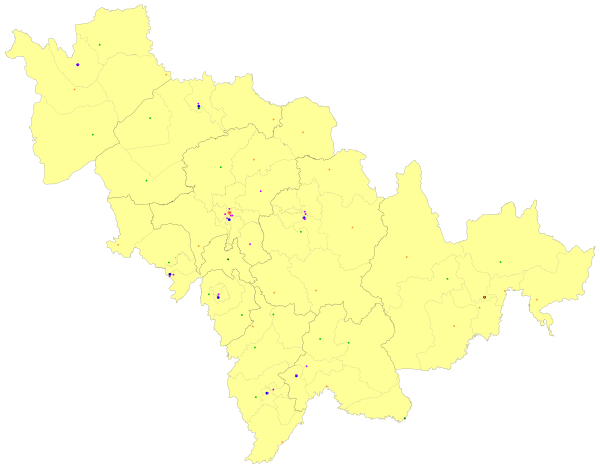 Changchun
Changchun431
(8-digit) Jilin
432
(8-digit) Siping
434 Liaoyuan
437 Tonghua
435 Baishan
439 Songyuan
438 Baicheng
436 Yanbian
433
1 - except Gongzhuling which still uses 434 of Siping
2 - Hunchun formerly 440, abolished in 16 September 2006
3 - Meihekou, Liuhe, Huinan formerly 448, abolished on 16 September 2006
Heilongjiang – 45x 46x
 Harbin
Harbin451
(8-digit) Qiqihar
452 Jixi
467 Hegang
468 Shuangyashan
469 Daqing
459 Yichun
458 Jiamusi
454 Qitaihe
464 Mudanjiang
453 Heihe
456 Suihua
455 Daxing'anling
Prefecture
457
1 -Acheng formerly 450, abolished.
2 - Includes Jiagedaqi and Songling, where considered part of Inner Mongolia by de jure
Inner Mongolia – 47x 48x
 Hohhot
Hohhot471 Baotou
472 Wuhai
473 Chifeng
476 Tongliao
475 Ordos
477 Hulunbuir
470 Bayannur
478 Ulanqab
474 Hinggan
League
482 Xilingol
League
479 Alxa
League
483
1 - Jiagedaqi and Songling are de facto under the administration of the Daxing'anling
Prefecture, uses 457.
Area 5 – Eastern China Operating Center
These are area codes for the provinces of Jiangsu, Shandong (predominantly), Anhui, Zhejiang and Fujian.
Jiangsu – 51x 52x
All telephone numbers are 8-digit in Jiangsu.
 Nanjing
Nanjing25 Wuxi
510 Xuzhou
516 Changzhou
519 Suzhou
512 Nantong
513 Lianyungang
518 Huai'an
517 Yancheng
515 Yangzhou
514 Zhenjiang
511 Taizhou
523 Suqian
527
1 - Changshu, Kunshan, Taicang, Wujiang and Zhangjiagang are formerly 520, abolished on 20 April 2002.
Shandong – 53x 54x
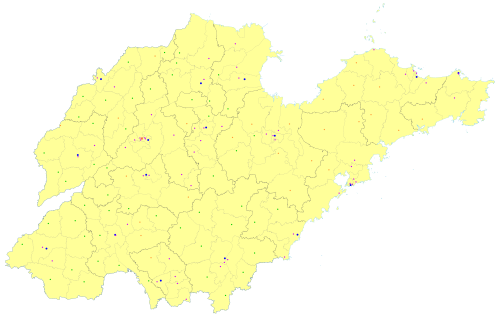 Jinan
Jinan531
(8-digit) Qingdao
532
(8-digit) Zibo
533 Zaozhuang
632 Dongying
546 Yantai
535 Weifang
536 Jining
537 Tai'an
538 Weihai
631 Rizhao
633 Linyi
539 Dezhou
534 Liaocheng
635 Binzhou
543 Heze
530
Anhui – 55x 56x
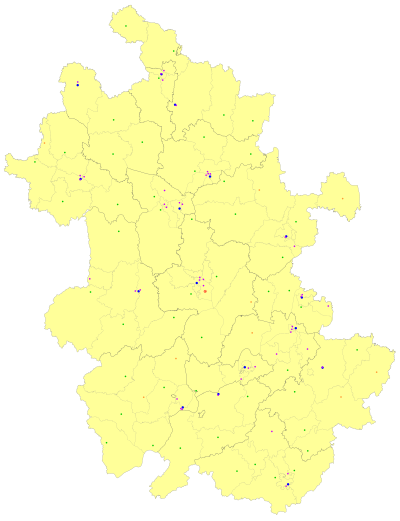 Hefei
Hefei551
(8-digit) Wuhu
553 Bengbu
552 Huainan
554 Ma'anshan
555 Huaibei
561 Tongling
562 Anqing
556 Huangshan
559 Chuzhou
550 Fuyang
558 Suzhou
557 Lu'an
564 Bozhou
558 Chizhou
566 Xuancheng
563
1 - Formerly 565 for Chaohu prefectural city era (i.e. before 2011), later split as: Hefei's 551 for Juchao district (now county-level Chaohu) and Lujiang county, Wuhu's 553 for Wuwei and Shenxiang Town of He county (now part of Jiujiang district), and Ma'anshan's 555 for He county (except Shenxiang) and Hanshan county.
2 - Split from Fuyang in 2000, no new area code allocated.
Zhejiang – 57x 58x
 Hangzhou
Hangzhou571
(8-digit) Ningbo
574
(8-digit) Wenzhou
577
(8-digit) Jiaxing
573
(8-digit) Huzhou
572 Shaoxing
575
(8-digit) Jinhua
579
(8-digit) Quzhou
570 Zhoushan
580 Taizhou
576
(8-digit) Lishui
578
Fujian – 59x 50x
 Fuzhou
Fuzhou591
(8-digit) Xiamen
592 Putian
594 Sanming
598 Quanzhou
595
(8-digit) Zhangzhou
596 Nanping
599 Longyan
597 Ningde
593
1 - Kinmen, Matsu, and Wuchiu are under Taiwanese control, and hence use international calling code of +886.
Area 6 – Supplement for Shandong(63x), Guangdong(66x), Yunnan(69x)
All area codes with prefix 6 were assigned in recent years. This prefix (+866) previously was reserved for Taiwan, which is now assigned (+886).
Shandong – 63x
While most areas in Shandong use the prefix 53x 54x, some sites also use the prefix 6.
Laiwu was using 634, now merged to Jinan's 531, former numbers are re-prefixxed as 5317 when merging.
Guangdong – 66x
While most areas in Guangdong use the prefix 75x and 76x, some sites also use the prefix 6. The provincial capital Guangzhou uses code 20.
Chaoyang county-level city was using 661, now changed to 754 after split to Chaoyang and Chaonan districts and join Shantou.
Yunnan – 69x
While most areas in Yunnan use the prefix 87x and 88x, a couple of areas also use the prefix 6.
- Xishuangbanna – 691
- Dehong – 692
Area 7 – Central-Southern China Operating Center
These are area codes for the central provinces of Hubei, Hunan, Guangdong (predominantly), Jiangxi, and the autonomous region of Guangxi.
Hubei – 71x 72x
 Wuhan
Wuhan27
(8-digit) Huangshi
714 Shiyan
719 Yichang
717 Xiangyang
710 Ezhou
711 Jingmen
724 Xiaogan
712 Jingzhou
716 Huanggang
713 Xianning
715 Suizhou
722 Enshi
718 Xiantao
728 Qianjiang
728 Tianmen
728 Shennongjia
719
20 - except Huarong district which uses Wuhan's 27.
Hunan – 73x 74x
 Changsha
Changsha731
(8-digit) Zhuzhou
731
(8-digit) Xiangtan
731
(8-digit) Hengyang
734 Shaoyang
739 Yueyang
730 Changde
736 Zhangjiajie
744 Yiyang
737 Chenzhou
735 Yongzhou
746 Huaihua
745 Loudi
738 Xiangxi
743
21 - Formerly 733, abolished.
22 - Formerly 732, abolished.
Guangdong – 75x 76x
 Guangzhou
Guangzhou20 (8-digit) Shaoguan
751 Shenzhen
755 (8-digit) Zhuhai
756 Shantou
754
(8-digit) Foshan
757
(8-digit) Jiangmen
750 Zhanjiang
759 Maoming
668 Zhaoqing
758 Huizhou
752 Meizhou
753 Shanwei
660 Heyuan
762 Yangjiang
662 Qingyuan
763 Dongguan
769 (8-digit) Zhongshan
760 (8-digit) Chaozhou
768 Jieyang
663 Yunfu
766 ↑
Macau
+853
Hong Kong
+852
23 - Shunde formerly 765, abolished.
Guangxi – 77x 78x
 Nanning
Nanning771 Liuzhou
772 Guilin
773 Wuzhou
774 Beihai
779 Fangchenggang
770 Qinzhou
777 Guigang
775 Yulin
775 Baise
776 Hezhou
774 Hechi
778 Laibin
772 Chongzuo
771
24 - Split from Wuzhou Prefecture, original area code inherited.
25 - Split from Liuzhou Prefecture, original area code inherited.
26 - Split from Yulin Prefecture, original area code inherited.
27 - Split from Nanning Prefecture, original area code inherited.
Jiangxi – 79x 70x
 Nanchang
Nanchang791
(8-digit) Jingdezhen
798 Pingxiang
799 Jiujiang
792 Xinyu
790 Yingtan
701 Ganzhou
797 Ji'an
796 Yichun
795 Fuzhou
794 Shangrao
793
Area 8 -Southwestern China Operating Center
These are area codes for the provinces of Sichuan, Hainan, Guizhou, Yunnan (predominantly) and the autonomous region of Tibet.
Sichuan – 81x 82x 83x
 Chengdu
Chengdu28 (8-digit) Zigong
813 Panzhihua
812 Luzhou
830 Deyang
838 Mianyang
816 Guangyuan
839 Suining
825 Neijiang
832 Leshan
833 Nanchong
817 Meishan
28
(8-digit) Yibin
831 Guang'an
826 Dazhou
818 Ya'an
835 Bazhong
827 Ziyang
28 (8-digit) Ngawa (Aba)
837 Garzê (Ganzi)
836 Liangshan
834
Guizhou – 85x 86x
 Guiyang
Guiyang851
(8-digit) Liupanshui
858 Zunyi
851
(8-digit) Anshun
851
(8-digit) Bijie
857 Tongren
856 Qianxinan
859 Qiandongnan
855 Qiannan
854
28 - Formerly 852, 853, abolished 2014.
Yunnan – 87x 88x
 Kunming
Kunming871
(8-digit) Qujing
874 Yuxi
877 Baoshan
875 Zhaotong
870 Lijiang
888 Pu'er
879 Lincang
883 Chuxiong
878 Honghe
873 Wenshan
876 Xishuangbanna
691 Dali
872 Dehong
692 Nujiang
886 Dêqên (Diqing)
887
29 - Dongchuan formerly 881, incorporated into 871
30 - also de facto used by Wa State of ![]() Myanmar
Myanmar
Tibet/Xizang – 89(1–7)
 Lhasa
Lhasa891 Shigatse / Xigazê
892 Chamdo / Qamdo
895 Nyingchi
894 Shannan / Lhoka
893 Nagqu
896 Ngari
897 ☐ Disputed areas claimed or controlled by
Hainan – 898
All telephone numbers are 8-digit in Hainan.
Formerly (most likely before 2000), Sanya, Wuzhishan, Lingshui, Ledong, Baoting and Qiongzhong were 899, Danzhou, Dongfang, Lingao, Baisha and Changjiang were 890.
Area 9 – Northwestern China Operating Center
These are area codes for northwestern regions including the provinces of Shaanxi, Gansu and Qinghai, as well as the autonomous regions of Ningxia and Xinjiang.
Shaanxi (陕西) – 91x 92x
 Xi'an
Xi'an29
(8-digit) Tongchuan
919 Baoji
917 Xianyang
29
(8-digit) Weinan
913 Yan'an
911 Hanzhong
916 Yulin
912 Ankang
915 Shangluo
914
Gansu – 93x 94x
 Lanzhou
Lanzhou931 ↑ ↑ ↑ ↑ ↑ Jiayuguan
937 Jinchang
935 Baiyin
943 Tianshui
938 Wuwei
935 Zhangye
936 Pingliang
933 Jiuquan
937 Qingyang
934 Dingxi
932 Longnan
939 Linxia
930 Gannan
941
31 - Shared area code due to small size.
Ningxia – 95x 96x
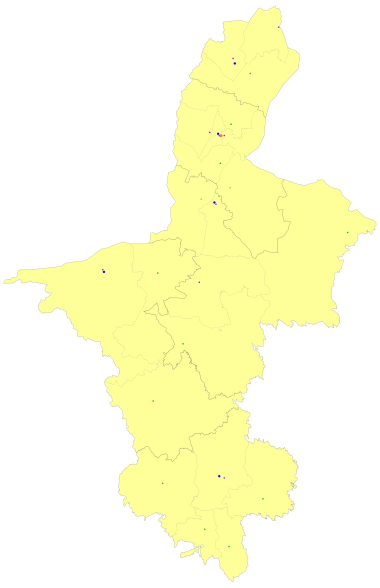 Yinchuan
Yinchuan951 Shizuishan
952 Wuzhong
953 Guyuan
954 Zhongwei
955
Qinghai – 97x 98x
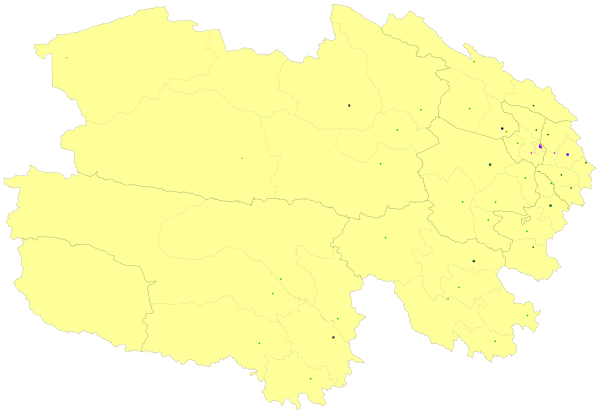 Xining
Xining971 Haidong
972 Haibei
970 Huangnan
973 Hainan
974 Guoluo (Golog)
975 Yushu
976 Haixi
977, 979 (Haixi)
979
32 - Area under the administration of Golmud uses 979, other landlines within the prefecture use 977.
Xinjiang – 99x 90x
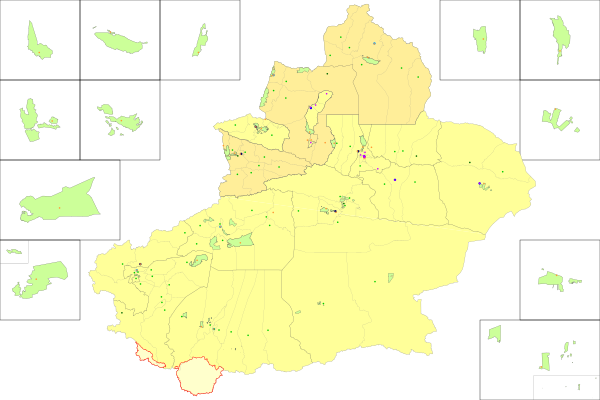 Ürümqi
Ürümqi991 Kuitun
992 Shihezi
993 Changji
994 Turpan
995 Bayingolin
996 Aksu
997 Kashgar
998 rest of Ili
999 Karamay
990 Tacheng
901 Hami
902 Hotan
903 Altay
906 Kizilsu
908 Bortala
909
33 - except Wusu and Dushanzi District which use Kuytun's 992.
34 - except Shawan county which uses Shihezi's 993, and Hoboksar county which uses Karamay's 990.
Emergency numbers
From within Mainland China, the following emergency numbers are used:
- 110 – Police (12110 for SMS to police, not for calling, 95110 for maritime policies, 96110 to report frauds)
- 119 – Fire brigade (12119 for forest fire in some regions)
- 120 – Ambulance
- 122 – Traffic accident (incorporated into 110 in some cities) (12122 on expressways)
- 999 – Privately operated ambulance (Beijing ONLY, calls outside Beijing is 010-999)
In most cities, the emergency numbers assist in Mandarin Chinese and English.
Starting from 2012 in Shenzhen, an implemented system upgrade to unify three emergency reporting services into one number, 110. A similar approach is being installed in more cities in China to make them more convenient.
Dialing 112, 911, and 999 (outside Beijing without area code 010) plays a recording message about the correct emergency numbers in Chinese and English twice: "For police, dial 110. To report a fire, dial 119. For ambulance, dial 120. To report a traffic accident, dial 122." on China Mobile and China Unicom phones, NO SERVICES will be redirected. The error messages "Number does not exist" will be played on China Telecom phones, and NO SERVICES will be redirected. However, some local report said that in sometimes, only within Beijing, China Unicom landlines and mobile phones call 010-112 may be successful as reporting service for call failures.
Others
From within Mainland China, the following special numbers are used:
- 100xx – Telecommunications Customer Service
- 10000 for China Telecom, formerly 1000
- 10010 for China Unicom, 10015 for auditing CU's services, formerly 1001
- 10020-10049 for VNOs
- 10086 for China Mobile (formerly 1860), 10050 for Tietong, 10080 for auditing CM's services, 1008611 for directly checking phone bills
- 10096 for China Tower
- 10099 for China Broadnet
- 106 – SMS access code
- 11185 – Post (11183 for their EMS)
- 114 – Directory assistance, operated by China Unicom for the northern 10 provinces, and China Telecom for the southern 21 provinces. China Unicom also operates 116114, and China Telecom 118114 that provide the same service as 114.
- 116xxx – Premium service of China Unicom (e.g. 116114)
- 118xxx – Premium service of China Telecom (e.g. 118114)
- 12114 – SMS name and address standard trial platform, not for calling
- 12117 – Speaking clock
- 12121 – Weather
- 12123 – Traffic police services
- 123xx – Government service, 12345 is a general hotline for all services below, that may be transited by 12345 operators upon kind of requests:
12303 – proposals
12305 – SPB post appeals
12306 – railway services
(10-)12308 – MFA Consular assistance
12309 – SPP reports
12310 – CIOC reports
12313 – tobacco reports
12314 – water reports
12315 – consumer reports
12316 – agricultural services
(10-)12317 – poverty helps
12318 – cultural reports
12319 – urban development services
12320 – health services
12321 – MIIT Internet disinfos and spam reports
12323 – MNR maritime report
12325 – food audit
12326 – CAAC audit
12328 – transportation illegal reports
12329 – housing fund services
12333 – MHRSS services
(10-)12335 – MoC Multinational corporation reports
12337 – CPLAC anti-blacks
12338 – women helps
12339 – MSS reports
12340 – statistics
12348 – MoJ legal services and aids
12350 – MEM safety reports
12351 – ACFTU workers' helps
12355 – CYL Adolescence services
12360 – custom services
12361 – PDCCP Xuexi Qiangguo
12363 – PBC financial reports
12366 – tax services
12367 – immigration services
12368 – court services
12369 – environment reports
(10-)12370 – MHRSS Civil services
12371 – ODCCP community member consult
12377 – CAC Internet illegal and disinfo reports
12378 – CBIRC reports
(10-)12379 – MEM emergency situation info release
12380 – ODCCP reports
12381 – MIIT public services
12385 – disabled services
12386 – CSRC Investor services
12388 – CCDI and NSC reports
12389 – MPS reports
12390 – anti-pornography, illegal and copyvio publishing reports
12393 – NHSA services
12395 – MSA Shipwrecking helps
12398 – energy audits
- 124x – Carrier Identification Code (formerly 190/196/197, abolished in 2018, to create space for mobile phone numbers.)
- 125xx – Premium service of China Mobile (e.g. 12580 for China Mobile's Directory assistance)
- 179xx + target number followed – VoIP (e.g. 17901-133-0000-0000, 1790 for China Telecom, 1791 for China Unicom, and 1795 for China Mobile)
- 400 xxx xxxx, 800 xxx xxxx – business numbers
- Differences: bills for 400 numbers are paid by both originating and terminating callers, and support calling from both landlines and mobile phones (usually 400-1/7 operate by China Mobile, 400-0/6 operate by China Unicom, 400-8/9 operate by China Telecom); bills for 800 numbers are just paid by terminating callers, but for non-landline users, mostly only China Telecom mobile phones may call 800 phones, because nearly all 800 phones are operated by China Telecom
- 400-881-0000 for auditing China Telecom's services
- 95xxx, 95xxxx, 95105xxx- Service number (nationally)
- 955xx – Bank, Insurance, Airlines service hotline, (nationally, ex. 95588 – Industrial and Commercial Bank of China (ICBC) )
- 96xxx, 96xxxx – Service number (locally, area code needed for calls from other provinces or autonomous region or province-level municipality.)
(ex. 962288 in Shanghai – Shanghai foreigner assistant hotline, outside Shanghai people should dial 021-962288, or they will receive an error message or undesired service message)
Former
- 20x (mainly 200 and 201) – was used for IC telephone service, to be reserved for mobile phones
- +86-10-68995110 when located at EEZs or public seas, where mobile signals are unable to provide
- SMS only, calling 12345 for this purpose will be hung up, with a SMS instruction returned
- ^ calling center merged with 12345, but numbers and service seats still work
- ^ calling center and seats merged with 12345, but numbers still work
- remote users are only able to receive phones from 12340, they can't directly call this number
International Access Code
The international access code from the PRC is 00. This must also be used for calls to Taiwan, Hong Kong and Macau from the Chinese mainland, together with their separate international codes, as follows:
| place! Prefix | |
|---|---|
| (All countries) | 00 CountryCode AreaCode SubscriberCode |
| Taiwan | 00 886 xxx xxx xxx |
| Hong Kong | 00 852 xxxx xxxx |
| Macau | 00 853 xxxx xxxx |
| NANP | 00 1 xxx xxx xxxx |
| UK | 00 44 xxxxxxxxxx |
| Japan | 00 81 xxxxxxxxx |
See also
- Telecommunications in China
- Telephone numbers in Hong Kong
- Telephone numbers in Macau
- Toll-free telephone number, China
References
- "工信部:已实现全部电话用户实名登记". 新华社. 2017-01-18. Archived from the original on 2019-02-19. Retrieved 2017-01-18.
- ""携号转网"正式启动,工信部点名"百年套餐"等障碍" (in Chinese (China)). 第一财经. 2019-11-27. Archived from the original on 2020-11-04. Retrieved 2019-11-29.
- "携号转网新规正式施行!权威解答来了!". 澎湃新闻. Archived from the original on 2019-12-10. Retrieved 2019-12-10.
- ^ "中国电信提出要加快2G/3G退网 原计划2024年底完成但貌似还要提前" (in Chinese). 29 September 2022.
- "中国移动2G网络退网公告:全面升级4G/5G,提升用户体验". 2023-09-17.
- "中国电信800M黄金频率再获1M频段,CDMA准备退网 - 中国电信,CDMA,800M频率,4G - IT之家". www.ithome.com. Archived from the original on 2019-04-07. Retrieved 2019-04-07.
- "沈阳、抚顺、铁岭正式开始共用"024"长途区号-搜狐新闻".
- "成都眉山资阳三地将共用长途区号028_新闻中心_新浪网".
- "西安咸阳今夜电话同区号-搜狐新闻".
- "中国的区号为什么缺026?_话题广场_评论频道_腾讯网". Tencent News. Archived from the original on 2014-05-21. Retrieved 2018-07-13.
- "区号026争夺与台北猜想". Tencent News. Archived from the original on 2007-10-22. Retrieved 2009-01-27.
- "026区号之争民间热议官方低调 长株潭并未申报". Sohu News. 2009-01-14. Retrieved 2022-09-05.
- The story of Taiwan's calling code Archived 2016-02-08 at the Wayback Machine, Taipei Times, October 5, 2010
- Nanhai No. 1 & Guangdong Maritime Silk Road Museum Archived 2016-10-11 at the Wayback Machine
- "贵阳遵义安顺实现通信同城化 共享区号0851".
- China Vista Archived 2022-10-31 at the Wayback Machine, Eugene Law, China Intercontinental Press, 2004, page 519
- China International Business: The Monthly Publication of the Ministry of Foreign Trade and Economic Cooperation, P.R.C Archived 2022-10-31 at the Wayback Machine, Issues 7–12, Ministry of Foreign Trade and Economic Cooperation, 2002
- China Law Archived 2022-10-31 at the Wayback Machine, Issues 1–6, 2008, page 50
- "ITU allocations list". ITU-T. Archived from the original on 2009-08-02.
External links
- "Chinese Mobile Phone Directory" (in Chinese). Archived from the original on 2012-10-24.